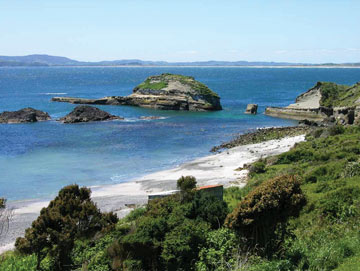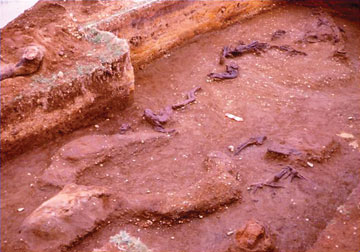|
NEWS NOTES
Seaweed confirms Monte Verde dates, but also migration patterns?
 Courtesy of Mario Pino |
| A rocky shoreline along the inland marine bay south of Monte Verde. Below: Archaeologists found traces of seaweed at Monte Verde in the remains of what they think was a medicinal hut. |
 Courtesy of Tom Dillehay |
In the late 1970s, the discovery of Monte Verde in southern Chile shook up early American archaeology. The site’s excavators dated the campsite — complete with the remains of huts, tents, hearths and tools — to more than 14,000 years old, making it at least 1,000 years older than any other known New World site. Monte Verde’s age and location suggested that not only had people arrived far earlier than expected, but also that they had made it a lot farther.
Not everyone accepted Monte Verde’s great antiquity. But now, seaweed recovered from hearths at the site confirms Monte Verde’s age. Furthermore, the great diversity of seaweed found there demonstrates that early Americans knew their way around coastal areas, researchers say — adding further evidence to the idea that the earliest immigrants populated the New World by traveling down the Pacific Coast, rather than dispersing along strictly inland routes as has traditionally been thought.
Tom Dillehay, an archaeologist at Vanderbilt University in Nashville, Tenn., has studied Monte Verde since its discovery, and over the years has collected more material than he has had time to study. So he only recently got around to analyzing samples he collected back in the mid-1980s, including three stone tools and the remains of nine seaweed species, he and his colleagues reported May 9 in Science. Using radiocarbon dating, the team determined that the seaweed is between 14,200 and 13,980 years old, which is in line with all previous dates from Monte Verde.
“It’s very important because it really fixes the age of the Monte Verde site,” says Daniel Sandweiss, an archaeologist at the University of Maine in Orono. Previous evidence, he says, has been debatable, but there’s no doubt that the seaweed was brought to Monte Verde and used by its residents. One of the stone tools had microscopic seaweed particles ingrained along its edge.
People at Monte Verde probably used the seaweed for food and medicine, just as local indigenous people do today. But to get it, they “had to go pretty far,” says co-author Jack Rossen, an archaeologist at Ithaca College in Ithaca, N.Y. At the time, Monte Verde was 90 kilometers away from the Pacific Ocean and 15 kilometers north of an inland marine bay. Collecting the seaweed wasn’t easy either. The species found at Monte Verde are available in different places in different seasons. And while some varieties wash up onshore, the only way to collect others would have been to wade into the water, Rossen says.
This is “suggestive of a fairly sophisticated knowledge of coastal ecosystems,” Dillehay says. But extrapolating migration patterns based on one site is difficult, Sandweiss notes. The research definitely shows that “people very early on knew how to use coastal resources, but it’s not necessarily the route of migration,” he says. “It’s hard to say how they came.”
Dillehay agrees, but says if more sites like Monte Verde are found, it might suggest a slow coastal migration down the Pacific Coast. He speculates people could have moved in a “zigzag” pattern — jutting inland to follow “thousands of temptations” along the way, such as rivers leading to mountains and other resources, and then returning back to continue southward down the coast. Part of the difficulty in testing the coastal migration hypothesis arises from the fact that sea level was lower in the past than it is today, so some archaeological sites are probably submerged. A more accessible place to look for early American sites might be along the “river systems tied into the Pacific,” Dillehay suggests, if people were indeed traveling in a “zigzag” fashion.

 Subscribe
Subscribe


